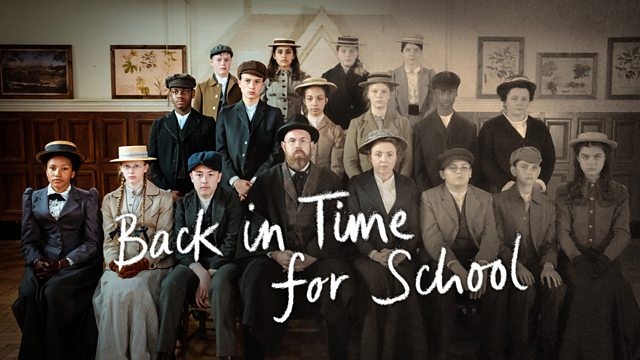
We watched Episode One which is summarised by the BBC as follows:
“Starting at the very close of Victoria’s reign they discover how national attitudes to class, race and gender filtered into the classroom, before entering the turbulent years between the World Wars. They experience lessons that seem bizarre by modern standards – from musket practise and mother-craft to deportment and duck herding – and take part in activities that we all remember from our own school days – the classic 80s cross-country run, the day Encarta enters British classrooms, and perhaps even master the puzzling gadget that was the 1960s slide rule.
Their experience begins in 1895. The smell of coal burners wafts down the corridor, and a portrait of Queen Victoria hangs proudly in the school hall. Our class discover what it was like for the lucky four per cent of children able to attend school in this period, when education was still seen as a preserve for the rich, but a handful of schools offered affordable places to ordinary families for the first time. In this age of Empire, the class comes to understand just how much attitudes have changed, and are shocked to discover that Victorian notions of Empire and citizenship are very different to modern ideas. School dinner is a silver-service affair, presided over by the teachers, whose authority is absolute. Alien to our 21st-century pupils’ eyes and palates, the menu offers them fish pie with a tapioca pudding, a meal the Victorian schoolchild would have been grateful for, at a time when many pupils worked part-time to support their family’s income and food supply – as some of our boys find out. With the advent of flash-photography powder, their chemistry teacher introduces them to a new scientific formula with an explosive bang, and one of the pupils is disciplined in an era-appropriate fashion by having his left hand tied to the desk.
With the death of Queen Victoria in 1902, the pupils and teachers enter into the Edwardian era. Segregation is common place in schools at this time, so our pupils are separated for gender-specific learning. While the boys enter into the possibility of the professions by learning Latin, the girls are tasked with more ladylike lessons – making beds, cleaning and putting up wallpaper, as they are taught the art of the housewifery. In 1904, the class and teachers gather with friends and family to celebrate Empire Day, a pageant common in schools throughout the Edwardian era. With students playing the roles of Peace and Britannia, their classmates flank them with banners proclaiming the reach of the British Empire, before singing the national anthem.
Towards the end of the era, the threat of war means the boys are trained in musket practise and learning to fight. The building desire for democracy has begun, and the girls come to understand how important the vote was to British women, as they learn the art of self-defence Suffragette style. As their time-travels draw to a close in 1914, and the pupils reflect on their Victorian experience, the school holds a prize-giving ceremony. A mark of academic achievement, which seeks to imbue the children with a sense of pride and responsibility, in order for them to fulfil their roles in society, in the testing and troubling years that will follow.” https://www.bbc.co.uk/programmes/b0bx7lxt
Here are our thoughts following the programme:
- Only four per cent of children able to attend school in this period. Feels disgusted mainly, but a small part relieved as school didn’t sound so nice.
- Most children left school at 11 to go to work.
- One of the pupils is disciplined in an era-appropriate fashion by having his left hand tied to the desk. Literally something he was born with. We feel this was inhumane and insane.
- Girls were taught the same as boys up until 1902 when there was a change in the school system. Science and maths were very important subjects but replaced by Latin for boys and Needlework for girls. Children were now taught separately according to gender.
- Empire was a key topic in Geography. Empire Day was celebrated by 55,000 schools and 7 million children across the globe. We remarked on how racist attitude was taught as fact and how shocking that was.
- We had a change of monarch in 1901. Edward VI, the son of Queen Victoria became King. We think the children would have been upset by her death. We read more about mourning in the Victorian period here: https://www.psychologytoday.com/gb/blog/understanding-grief/201812/death-and-mourning-practices-in-the-victorian-age
